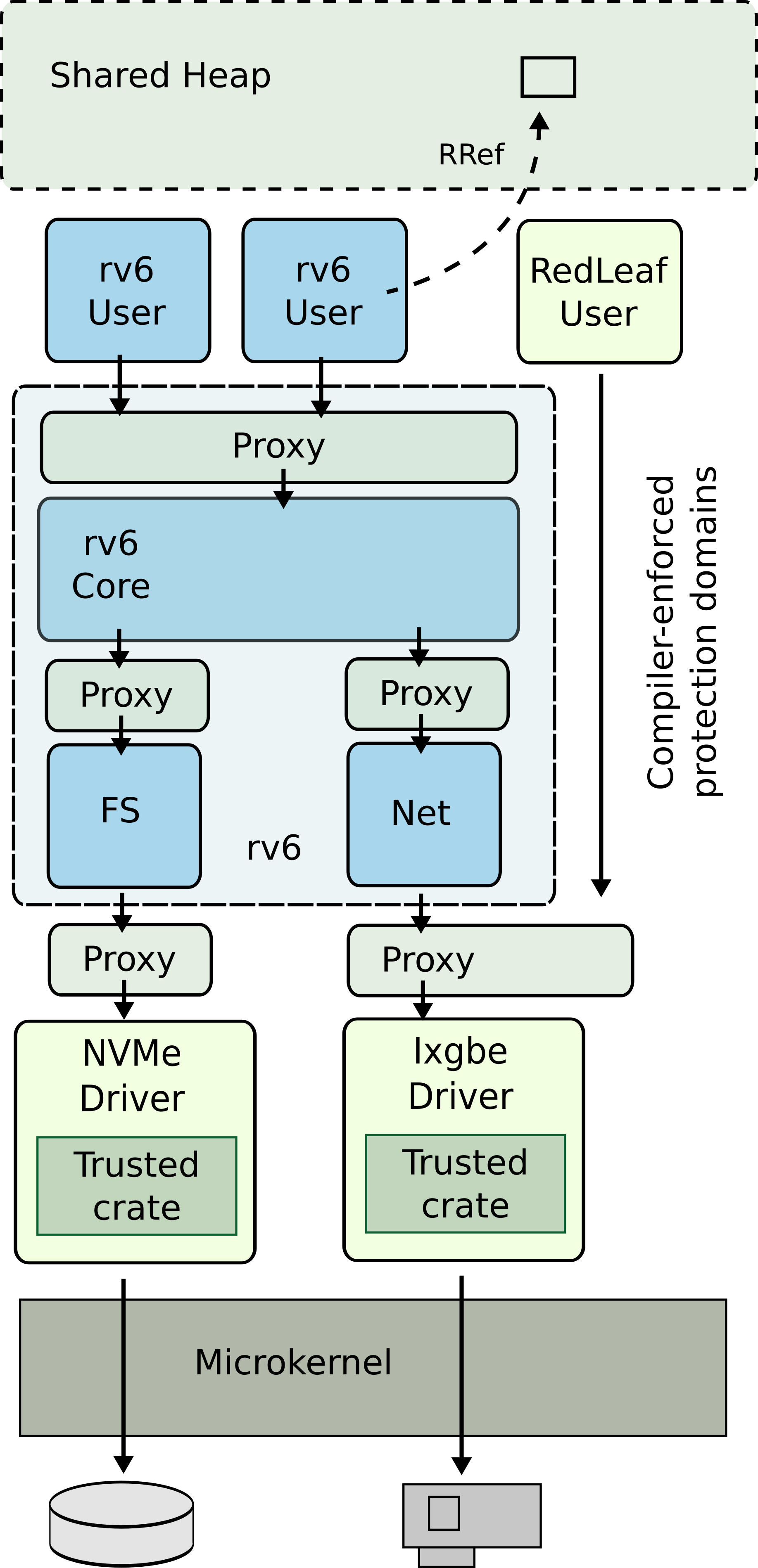
RedLeaf is a new operating system aimed at leveraging a safe, linear-typed programming language, Rust, for developing safe and provably secure systems. RedLeaf builds on two premises: (1) Rust's linear type system enables practical language safety even for systems with the tightest performance and resource budgets, e.g., OS kernels and firmware, (2) a combination of SMT-based reasoning and pointer discipline enforced by linear types provides a way to automate and simplify verification effort and scale it to the size of a small operating system kernel that can run firmware subsystems.
There are two main lines of the project: 1) leveraging language safety for exploring its impact on operating system organization, and 2) leveraging properties of linear types for verification.
Clean-Slate Safe Kernels
Since early computer systems developed five decades ago overheads of language safety remain prohibitive for development of operating system kernels. Today, we run kernels developed in C. Unfortunately, the choice of C, an unsafe low-level programming language, as the de facto standard for kernel development contributes to several hundred vulnerabilities a year.
Recently, however, the performance landscape of safe languages is starting to change with the development of programming languages like Rust that achieve safety without garbage collection. Rust is the first practical language that combines an old idea of linear types with pragmatic language design. Rust enforces type and memory safety through a restricted ownership model, where there exists a unique reference to each live object in memory. This allows statically tracking the lifetime of the object and deallocating it without a garbage collector. Rust represents a unique point in the language design space, bringing the benefits of type and memory safety to systems that cannot afford the cost of garbage collection. The runtime overhead of the language is limited to bounds checking, which is often hidden by modern superscalar out of order CPUs.
In contrast to commodity systems, RedLeaf does not rely on hardware address spaces for isolation and instead uses only type and memory safety of the Rust language. Departure from costly hardware isolation mechanisms allows us to explore the design space of systems that embrace lightweight fine-grained isolation.
RedLeaf is designed as a microkernel system in which a collection of language domains implement functionality of the system: kernel subsystems, device drivers, and user applications.
Rust provides systems developers with mechanisms we were all waiting for for decades: zero-cost language safety and a type system that enforces ownership. We argue that Rust’s language safety allows us to enable many classical ideas of operating system research for the first time in a practical way.
Verification
RedLeaf provides a Floyd-Hoare-style modular verification (i.e., based on pre-conditions, post-conditions, and loop invariants) for low-level systems that are designed to be fast and small. It achieves that by developing a new verification toolchain built on the SMACK verifier, Boogie intermediate verification language, and Z3 SMT solver.
In RedLeaf the choice of Rust is critical in two ways. First, Rust allows RedLeaf to leverage recent developments in the programming language community to simplify verification. RedLeaf builds on the premise that linear types are critical for creating a scalable automated verification infrastructure. In particular, Rust enforces (using its type system) a rigorous discipline for controlling of sharing and aliasing in the program heap. Dealing with sharing and aliasing is a well-known source of annotation and performance overheads in software verifiers, and having this aspect be controlled by the type system allows for a much more scalable verification. Unique properties of Rust's linear type system, and specifically its ability to lift the burden of resolving memory aliasing from the verifier, open a new page in the domain of practical and scalable verification.
Publications
-
Zhaofeng Li, Tianjiao Huang, Vikram Narayanan, Anton Burtsev. Understanding the Overheads of Hardware and Language-Based IPC Mechanisms. In 11th Workshop on Programming Languages and Operating Systems (PLOS), October 2021. pdf
-
Anton Burtsev, Dan Appel, David Detweiler, Tianjiao Huang, Zhaofeng Li, Vikram Narayanan, Gerd Zellweger. Isolation in Rust: What is missing?. In 11th Workshop on Programming Languages and Operating Systems (PLOS), October 2021. pdf
-
Vikram Narayanan, Tianjiao Huang, David Detweiler, Dan Appel, Zhaofeng Li, Gerd Zellweger, Anton Burtsev. RedLeaf: Isolation and Communication in a Safe Operating System. In 14th USENIX Symposium on Operating Systems Design and Implementation (OSDI), November 2020. pdf
-
Dan Appel. Inter-Process Communication in a Safe Kernel. BS Thesis. University of California, Irvine, 2020. pdf
-
Vikram Narayanan (University of California, Irvine), Marek S. Baranowski (University of Utah), Leonid Ryzhyk (VMware Research), Zvonimir Rakamaric (University of Utah), Anton Burtsev (University of California, Irvine). RedLeaf: Towards An Operating System for Safe and Verified Firmware. In 17th Workshop on Hot Topics in Operating Systems (HotOS), May 2019. pdf
Code
- RedLeaf Operating System: https://github.com/mars-research/redleaf
- RedLeaf IDL: https://github.com/mars-research/redIDL